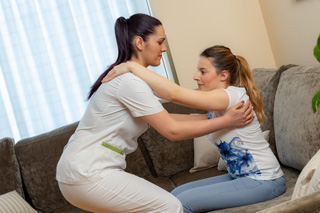
The CDC states that worker’s compensation claims are filed for back problems more than any other injury. This article will give healthcare employees information on how to combat these injuries in their workplace.
According to OSHA, costs associated with back injuries in the healthcare industry are estimated to be over 20 billion dollars annually. More than any other sector, healthcare workers report the highest number of days away for injury, citing the back as the most common reason.
Every year there are over 67,000 back injuries among healthcare workers because of their high risk of injury due to the lifting and transferring of patients. Employers are obligated to address these risks by implementing the required occupational health and safety training.
The Vulnerable BackThe back encompasses the spine, spinal chord, vertebrae, spinal discs for cushion, and over 1400 ligaments, tendons and muscles to stabilize. As a result, the back is susceptible to injuries caused by everyday tasks for healthcare workers. The most common risks of injury include:
In addition to work specific risks, everyday habits such as poor posture, poor sleeping position and lack of exercise, flexibility and back strength can increase the risk of on-the-job injury. Improper lifting is the single most common cause of back injury. With preparation and the use of proper lifting, carrying, and placing procedures, the risk of injury is significantly reduced.
General Techniques and Best PracticesPreparation begins by first assessing a situation to decide the appropriate assist equipment, proper techniques and number of people needed to reduce the risk of injury to patients and staff. Assessments should take place every time a patient is moved as their condition, effects of medicines and fatigue can change often.
Patient considerations should include weight, medical condition, recent surgery, body strength, and ability to see, hear or follow instructions. When appropriate, get assistance from other staff. Confirm you and colleagues have been properly trained with supervised practice if using specialized equipment for lifting.
This is true of moving items as well.
When placing a patient or item, set them down standing as close to the destination as possible. When lifting and lowering, bend at the legs, not at the waist. Bending at the waist will multiply the weight and apply pressure on the vertebrae in your spine.Do not lift directly after sitting for a long time. Encourage new employees, those returning from long absences, or those performing unfamiliar physical work to gradually increase the pace or difficulty of their activities.
Try to use proper techniques for all physical labor at work and at home.
Lateral Transfer Techniques
When performing a lateral transfer or repositioning when equipment is not available, follow these steps to ensure the best protection against back injury.
Use this practice in similar fashion when repositioning the patient.
Bed to Wheelchair Transfer Techniques
When transferring a patient from a bed to a wheelchair, safeguard your back by following these steps.
Wheelchair to Bed Transfer Techniques
When transferring a patient from a wheelchair to a bed, safeguard your back by following these steps.
Back Injury Prevention: Falls
It is always the goal to prevent falls from happening. Review patient assessments and watch for signs of weakness to prevent falls. If a patient starts to fall, you want to protect their head and as gently as possible guide them slowly to the floor while attempting to maintain a neutral posture. Trying to stop the fall is a very likely way to get injured. If a patient has fallen, get help to lift the patient from the floor and when medically appropriate, use a mechanical assist device.
Back Injury Prevention:
1. Posture, Sleep and Ergonomics
2 .Posture
Injuries can occur from sitting or standing for long periods of time with poor posture. Slouching or twisting at the waist puts pressure on back ligaments instead of muscles. The ligaments stretch and strain while putting pressure on vertebrae. A neutral posture is achieved when muscles and joints are resting and relaxed, placing minimal stress on body parts.
To keep a neutral posture and reduce pain while standing, always do the following:
To maintain correct neutral sitting posture and reduce pain you should:
Sleep
The best sleep position is on the back. It evenly distributes weight across the body and reduces pressure points. Side sleepers should alternate sides to decrease pressure points and place a pillow between the knees to align the spine. Avoid sleeping on the stomach as it puts pressure on the spine and places the neck in an unnatural position. When sleeping on a soft mattress, place plywood between the mattress and box spring for better support. Follow recommended guidelines for turning and replacing your mattress so that you are not making your back vulnerable while you sleep.
Ergonomics
There are simple ways to structure work areas to help prevent back injuries. Before beginning work tasks, take time to identify activities that create potential back strain or injury and adjust the worksite for them.
Back Injury Relief
Workers who are suffering from acute back pain should seek medical attention.
However if you have sustained a minor back injury that does not need medical care you can use or do the following to alleviate stiffness and soreness.
Follow some of these exercises to reduce back pain:
Conclusion
Back injury prevention training and use of proper lifting and other techniques is critical in the healthcare industry. The nature of the work makes healthcare workers especially vulnerable to injury when proper guidelines are not followed.
Proper training can help prevent injury, which in turn, reduces absenteeism, medical expenses, worker’s compensation and disability claims, turnover and operating costs. The protection and well-being of healthcare workers improves the quality of their lives and allows them to focus their attention on the well-being of the patients they serve.